Experimental Study on the Evolution Law of the Mechanical and Pore Characteristic Parameters of Set Cement under High- and Ultra-High-Temperature Treatments
Abstract
:1. Introduction
2. Materials and Methods
2.1. Subsection
2.2. Experimental Methodology
2.3. Subsection
2.3.1. NMR Experiments
2.3.2. Argon-Ion Polishing Electron Microscope Experiment
2.3.3. CT Scanning Experiment
3. Results and Discussion
3.1. Study on the Mechanical Properties of Cement
3.1.1. Stress–Strain Curve Analysis
3.1.2. Variation of Mechanical Parameters
3.2. Changes in Pore and Permeability Characteristics under Thermal Treatment
3.2.1. Aperture Distribution Analysis
3.2.2. Analysis of Pore Development
3.2.3. Relationship between Porosity and Permeability
3.3. Visualization Analysis of Sewage Sludge under High- and Ultra-High-Temperature Conditions
3.3.1. FE-SEM Imaging Analysis
3.3.2. CT Scanning Analysis
4. Conclusions
- Two types of high-temperature-resistant cement slurries were designed, and uniaxial compression tests were conducted after high-temperature and high-pressure curing. The results indicate that as the heating temperature continues to rise, the compressive strength of the set cement first increases (25 °C–200 °C) and then decreases (200 °C–600 °C), and the strength of the set cement reaches its peak after thermal treatment at 200 °C.
- The porosity and permeability characteristics of set cement after thermal treatment were measured using a low-field NMR experimental device. The results show that with the continuous increase in temperature, the porosity of cement paste first decreases (25 °C–115 °C) and then increases (115 °C–600 °C). The penetration first slowly increases (25 °C–400 °C) and then rapidly increases (400 °C–600 °C).
- Visualization experiments were conducted on the micro-cracks and pore distribution of set cement based on FE-SEM and CT scanning. The experimental results show that when the thermal treatment temperature is 200 °C–600 °C, the number of pores on the cement matrix after a thermal roughening treatment has significantly increased, and some pores have polymerized and formed micro-cracks.
Author Contributions
Funding
Data Availability Statement
Conflicts of Interest
References
- Zhao, Y.S.; Liang, W.G.; Feng, Z.J. Introduction to In-Situ Modification Mining by Fluidization; Science Press: Beijing, China, 2019; pp. 291–335. [Google Scholar]
- Feng, Z.J.; Zhao, Y.S.; Zhou, A.C.; Zhang, N. Development program of hot dry rock geothermal resource in the Yangbajing Basin of China. Renew. Energy 2012, 39, 490–495. [Google Scholar] [CrossRef]
- Yin, W.T.; Zhao, Y.S.; Feng, Z.J. Experimental research on the rupture characteristics of fractures subsequently filled by magma and hydrothermal fluid in hot dry rock. Renew. Energy 2019, 139, 71–79. [Google Scholar] [CrossRef]
- Zhao, Y.S.; Feng, Z.J.; Zhao, Y.; Wan, Z.J. Experimental investigation on thermal cracking, permeability under HTHP and application for geothermal mining of HDR. Energy 2017, 132, 305–314. [Google Scholar] [CrossRef]
- Martin, C.D.; Christiansson, R. Estimating the potential for spalling around a deep nuclear waste repository in crystalline rock. Int. J. Rock Mech. Min. Sci. 2009, 46, 219–228. [Google Scholar] [CrossRef]
- Bhutto, A.W.; Bazmi, A.A.; Zahedi, G. Underground coal gasification: From fundamentals to applications. Prog. Energy Combust. Sci. 2013, 39, 189–214. [Google Scholar] [CrossRef]
- Šolcová, O.; Soukup, K.; Rogut, J.; Stanczyk, K.; Schneider, P. Gas transport through porous strata from underground reaction source; The influence of the gas kind, temperature and transport-pore size. Fuel Process. Technol. 2009, 90, 1495–1501. [Google Scholar] [CrossRef]
- Wan, Z.J.; Feng, Z.J. The Coupled Thermo-Mechanical Characteristics of Coal and Their Application; Science Press: Beijing, China, 2014; pp. 130–145. [Google Scholar]
- Curiel-Esparza, J.; Canto-Perello, J.; Calvo, M.A. Establishing sustainable strategies in urban underground engineering. Sci. Eng. Ethics 2004, 10, 523–530. [Google Scholar] [CrossRef]
- CAE. The Blue Book of Urban Underground Space Development in China in 2021; Strategic Consulting Center of Chinese Academy of Engineering: Beijing, China, 2021. [Google Scholar]
- Yuan, Q.; Zhu, H.; Zhang, X.; Zhang, B.; Zhang, X. An Integrated Quantitative Risk Assessment Method for Underground Engineering Fires. Int. J. Environ. Res. Public Health 2022, 19, 16934. [Google Scholar] [CrossRef]
- She, L.; Chen, Z.; Zheng, Z.G. Urban Underground Space Risk Early Warning Management; Science Press: Beijing, China, 2014. [Google Scholar]
- Chen, Q.; Zhu, H.H.; Yan, Z.G.; Ju, J.W.; Jiang, Z.W.; Wang, Y.Q. A multiphase micromechanical model for hybrid fiber reinforced concrete considering the aggregate and ITZ effects. Constr. Build. Mater. 2016, 114, 839–850. [Google Scholar] [CrossRef]
- Ju, J.; Wu, Y. Stochastic micromechanical damage modeling of progressive fiber breakage for longitudinal fiber-reinforced composites. Int. J. Damage Mech. 2015, 25, 203–227. [Google Scholar] [CrossRef]
- Kale, S.; Ostoja-Starzewski, M. Representing stochastic damage evolution in disordered media as a jump Markov process using the fiber bundle model. Int. J. Damage Mech. 2016, 26, 147–161. [Google Scholar] [CrossRef]
- Park, S.M.; Yang, B.J.; Kim, B.R.; Ha, S.K.; Lee, H.K. Structural strengthening and damage behaviors of hybrid sprayed fiber-reinforced polymer composites containing carbon fiber cores. Int. J. Damage Mech. 2016, 26, 358–376. [Google Scholar] [CrossRef]
- Wu, Y.; Ju, J.W. Elastoplastic damage micromechanics for continuous fiber-reinforced ductile matrix composites with progressive fiber breakage. Int. J. Damage Mech. 2016, 26, 4–28. [Google Scholar] [CrossRef]
- Yan, Z.G.; Zhang, Y.; Ju, J.W.; Chen, Q.; Zhu, H.H. An equivalent elastoplastic damage model based on micromechanics for hybrid fiber-reinforced composites under uniaxial tension. Int. J. Damage Mech. 2017, 28, 79–117. [Google Scholar] [CrossRef]
- Ma, Q.M.; Guo, R.X.; Zhao, Z.M.; Lin, Z.W.; He, K.C. Mechanical properties of concrete at high temperature—A review. Constr. Build. Mater. 2015, 93, 371–383. [Google Scholar] [CrossRef]
- Xiao, J.Z.; König, G. Study on concrete at high temperature in China—An overview. Fire Saf. J. 2004, 39, 89–103. [Google Scholar] [CrossRef]
- Xiao, J.Z.; Xie, Q.H.; Xie, W.G. Study on high-performance concrete at high temperatures in China (2004–2016)—An updated overview. Fire Safety J. 2018, 95, 11–24. [Google Scholar] [CrossRef]
- Phan, L.T.; Carino, N.J. Review of mechanical properties of HSC at elevated temperature. J. Mater. Civil Eng. 1998, 10, 58–65. [Google Scholar] [CrossRef]
- Lin, Y.H.; Deng, K.H.; Yi, H.; Zeng, D.Z.; Tang, L.; Wei, Q. Integrity tests of cement sheath for shale gas wells under strong alternating thermal loads. Nat. Gas Ind. B 2020, 7, 671–679. [Google Scholar] [CrossRef]
- Zhang, G.Y.; Wu, Z.Q.; Cheng, X.W.; Sun, X.L.; Zhang, C.M.; Zhou, M. Mechanical properties of high-ferrite oil-well cement used in shale gas horizontal wells under various loads. Constr. Build. Mater. 2022, 319, 126067. [Google Scholar] [CrossRef]
- Li, H.L.; Pang, X.Y.; Zhang, J.; Shi, X. Mechanical properties of low-density cement under shale oil in-situ conversion conditions. Constr. Build. Mater. 2023, 393, 131970. [Google Scholar] [CrossRef]
- Zhang, Y.H.; Xu, M.B.; Song, J.J.; Wang, C.L.; Wang, X.L.; Hamad, B.A. Study on the corrosion change law and prediction model of set cement in oil wells with CO2 corrosion in ultra-high-temperature acid gas wells. Constr. Build. Mater. 2022, 323, 125879. [Google Scholar] [CrossRef]
- Hao, H.Y.; Song, J.W.; Chen, M.Z.; Yan, X.; Zhang, K.F. Rheological and mechanical properties of oil-well cement reinforced by hybrid inorganic fibers. Constr. Build. Mater. 2023, 377, 131002. [Google Scholar] [CrossRef]
- Bathija, A.P.; Boyd, P.; Martinez, R. Cement sheath integrity at simulated reservoir conditions of pressure, temperature, and wellbore configuration in a laboratory setup. Geoenergy Sci. Eng. 2023, 232, 212446. [Google Scholar] [CrossRef]
- Sun, L.J.; Pang, X.Y.; Liu, H.J.; Wang, C.C.; Yu, J.W.; Zhao, P.Y. Experimental study of pure Class G cement hydration up to 150 °C and 50 MPa. J. Mater. Res. Technol. 2023, 25, 1463–1482. [Google Scholar] [CrossRef]
- Weibel, R.; Olivarius, M.; Jakobsen, F.C.; Whitehouse, M.; Larsen, M.; Midtgaard, H.; Nielsen, K. Thermogenetic degradation of early zeolite cement: An important process for generating anomalously high porosity and permeability in deeply buried sandstone reservoirs? Mar. Petrol. Geol. 2019, 103, 620–645. [Google Scholar] [CrossRef]
- Bai, S.; Yu, L.B.; Guan, X.C.; Li, H.; Ou, J.P. Study on the long-term chloride permeability of nano-silica modified cement pastes cured at negative temperature. J. Build. Eng. 2022, 57, 104854. [Google Scholar] [CrossRef]
- Yin, T.B.; Li, Q.; Li, X.B. Experimental investigation on mode I fracture characteristics of granite after cyclic heating and cooling treatments. Eng. Fract. Mech. 2019, 222, 106740. [Google Scholar] [CrossRef]
- Li, Q.; Li, X.B.; Yin, T.B. Factors affecting pore structure of granite under cyclic heating and cooling: A nuclear magnetic resonance investigation. Geothermics 2021, 96, 102198. [Google Scholar] [CrossRef]
- Xi, Y.; Xing, J.H.; Jiang, H.L.; Fan, L.F.; Li, J. Pore characteristic evolution and damage deterioration of granite subjected to the thermal and cooling treatments combined with the NMR method. Bull. Eng. Geol. Environ. 2023, 85, 182. [Google Scholar] [CrossRef]
- Fan, L.F.; Gao, J.W.; Du, X.L.; Wu, Z.J. Spatial gradient distributions of thermal shock-induced damage to granite. J. Rock Mech. Geotech. 2020, 12, 917–926. [Google Scholar] [CrossRef]
- Qiao, Y.F.; Xiao, Y.M.; Ding, W.Q.; He, M.C. Effect of rock nonlinear mechanical behavior on plastic zone around deeply buried tunnel: A numerical investigation. Comput. Geotech. 2023, 161, 105532. [Google Scholar] [CrossRef]
- Xu, Y.Y.; Tang, T.T.; Liu, M.; Huang, J.Q. Experimental investigation of post-fire seismic behavior of reinforced high-strength concrete shear walls. Eng. Struct. 2023, 297, 117010. [Google Scholar] [CrossRef]

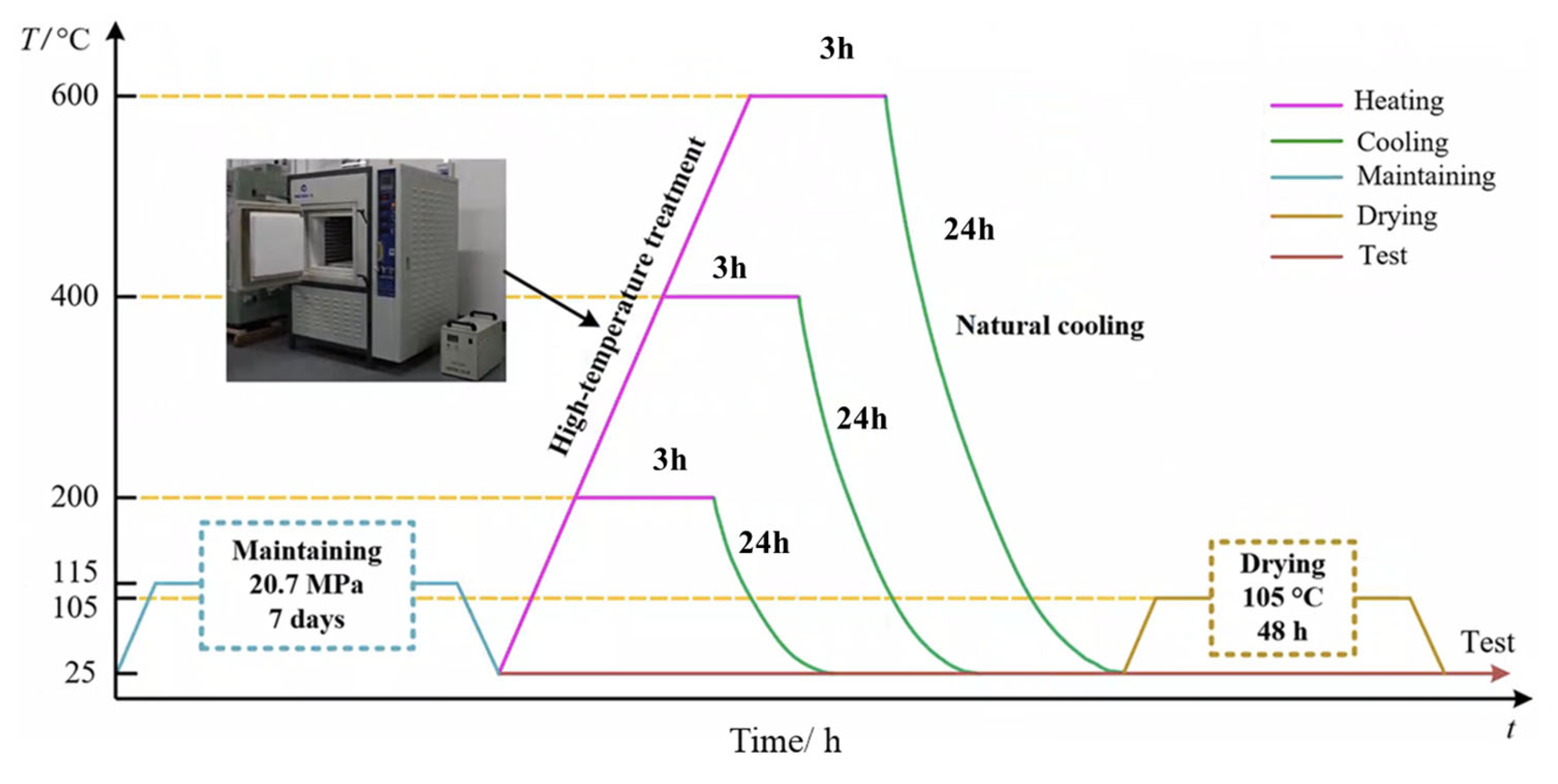

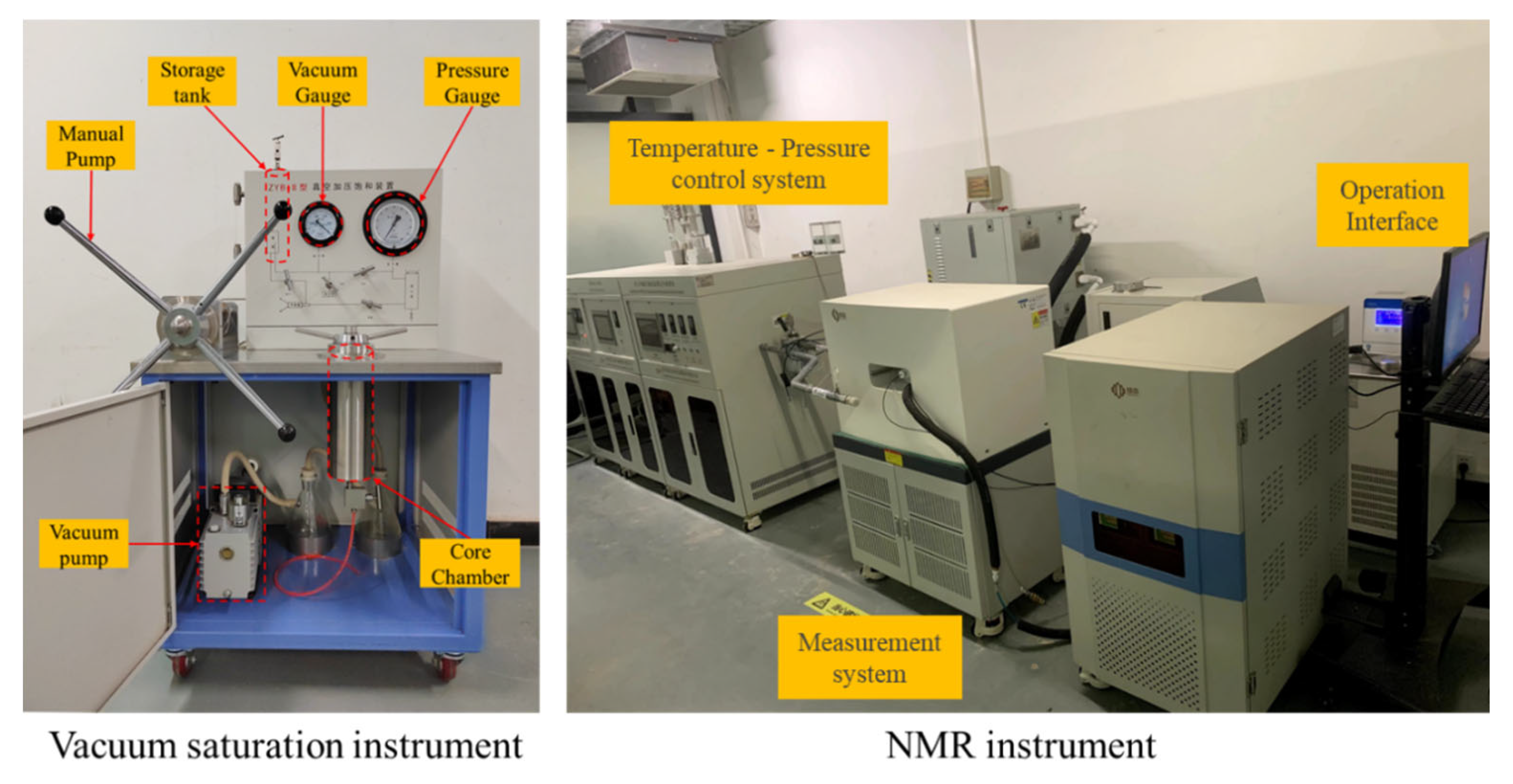
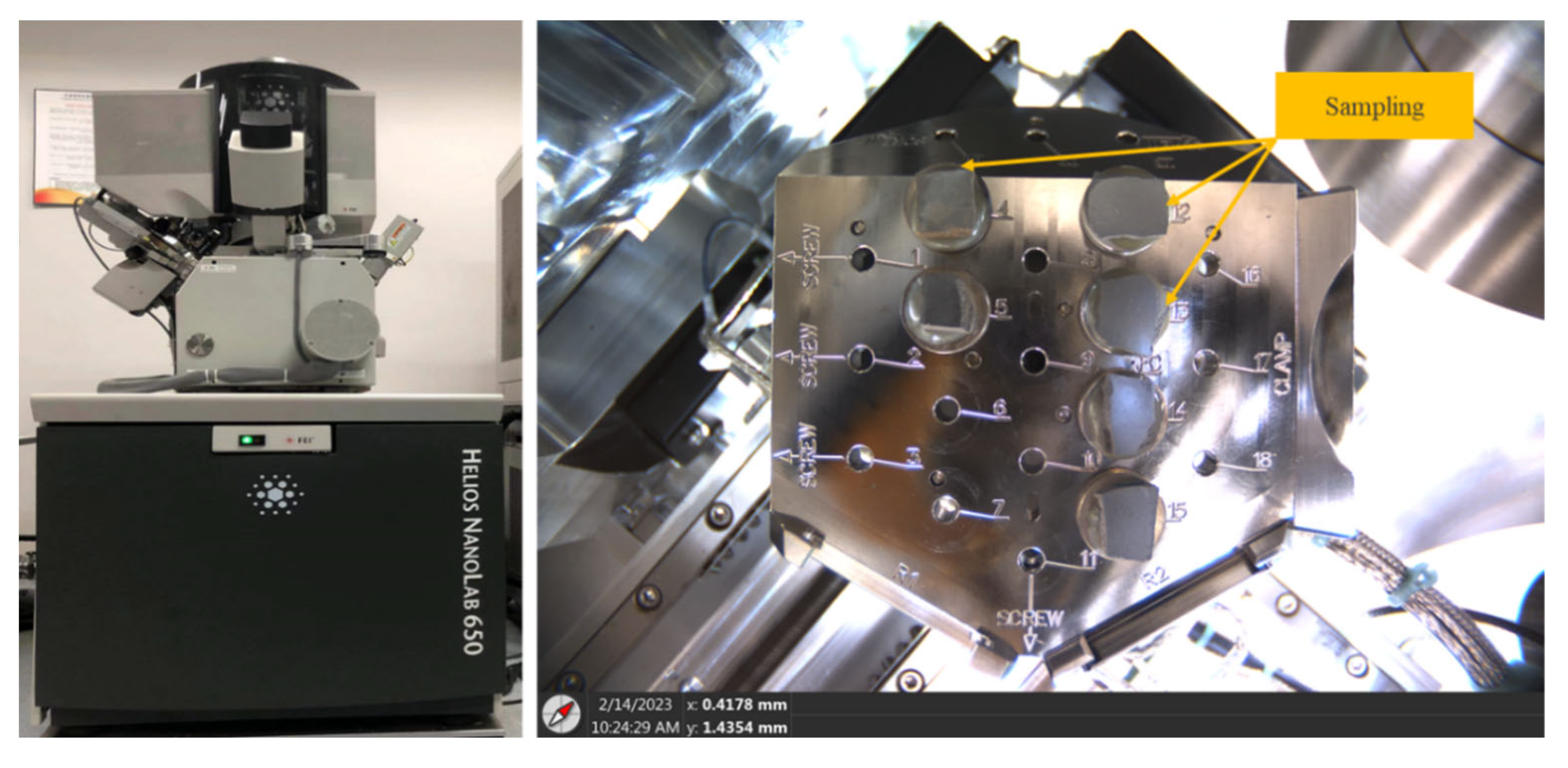
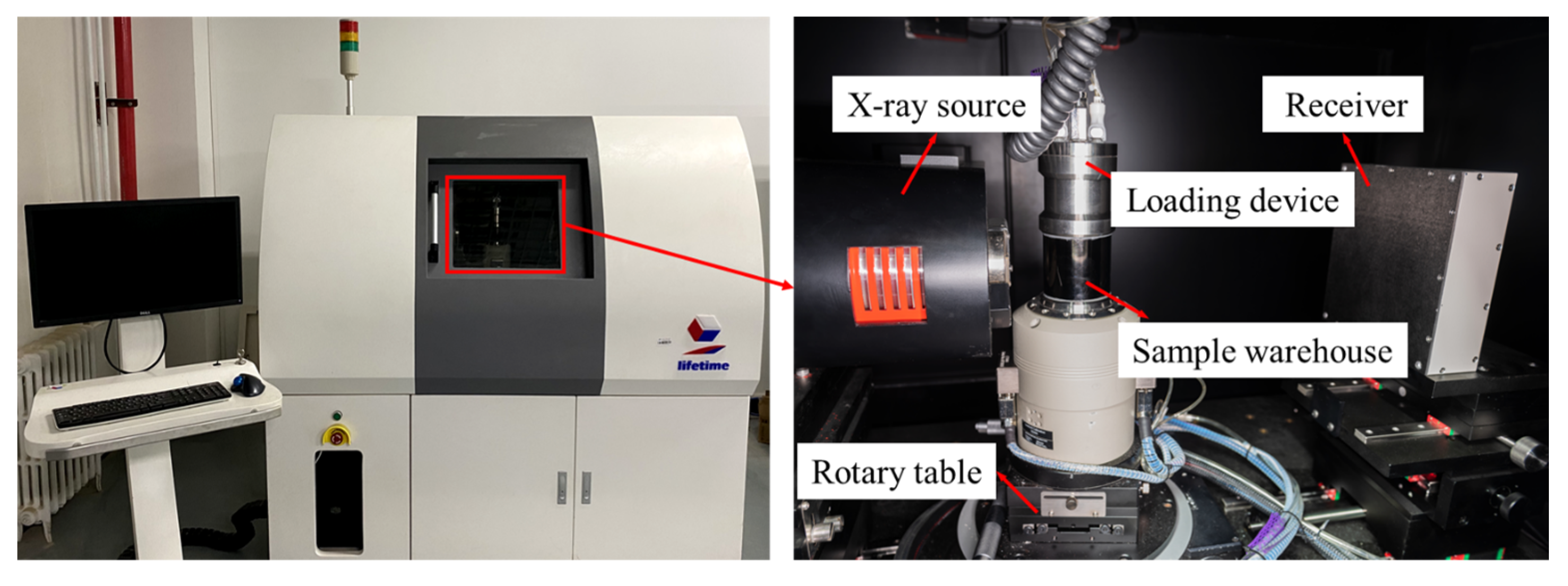
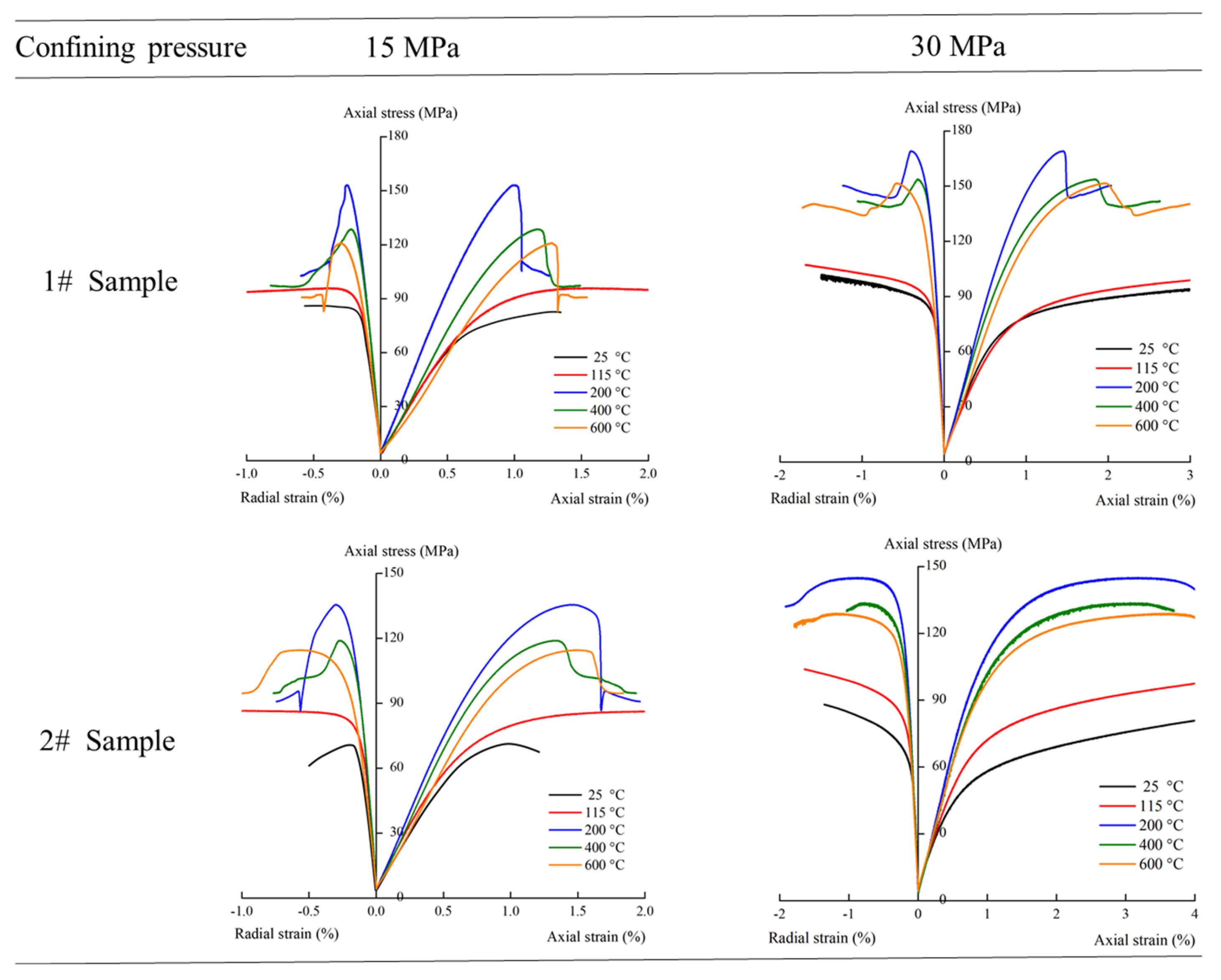
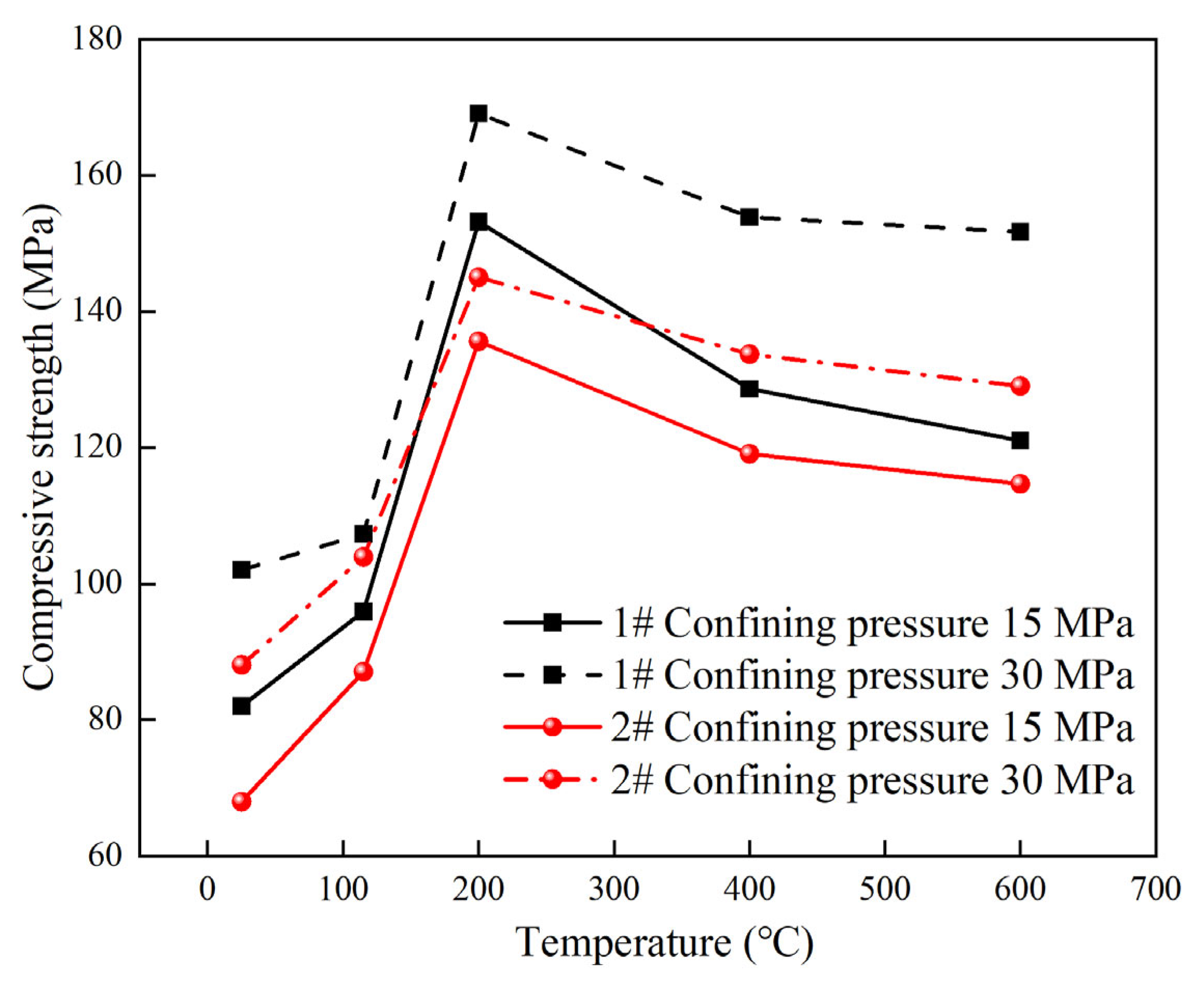
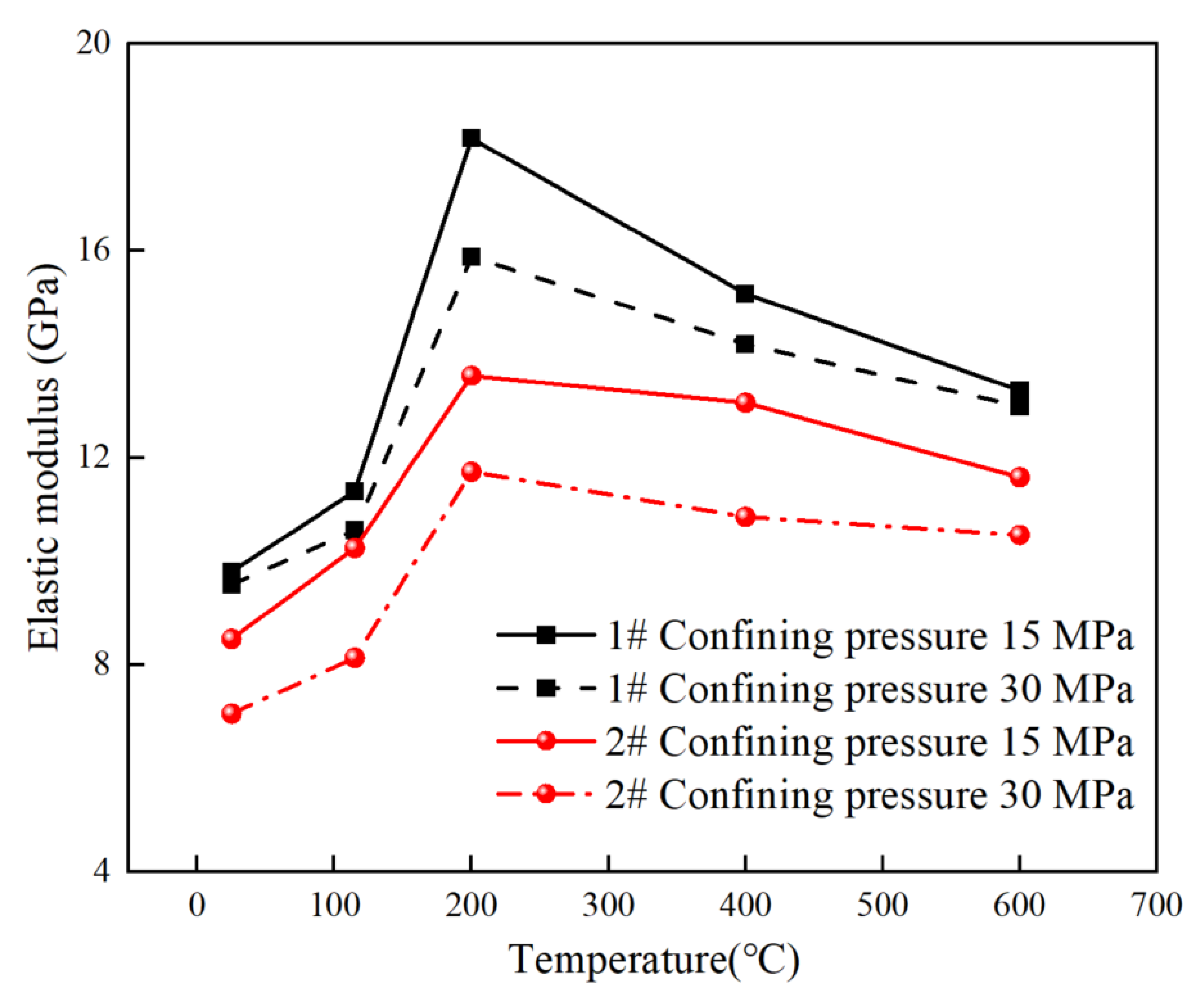
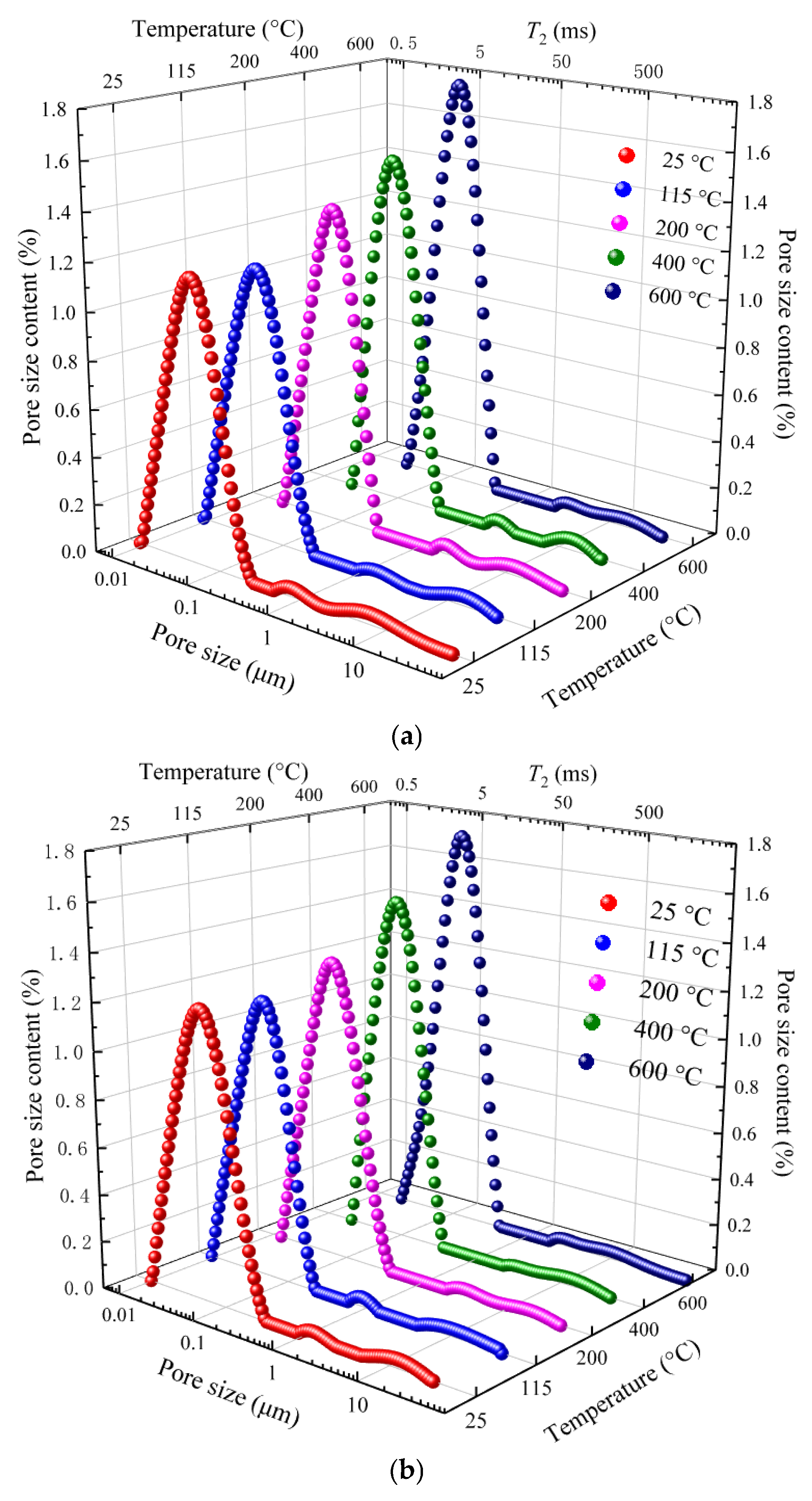
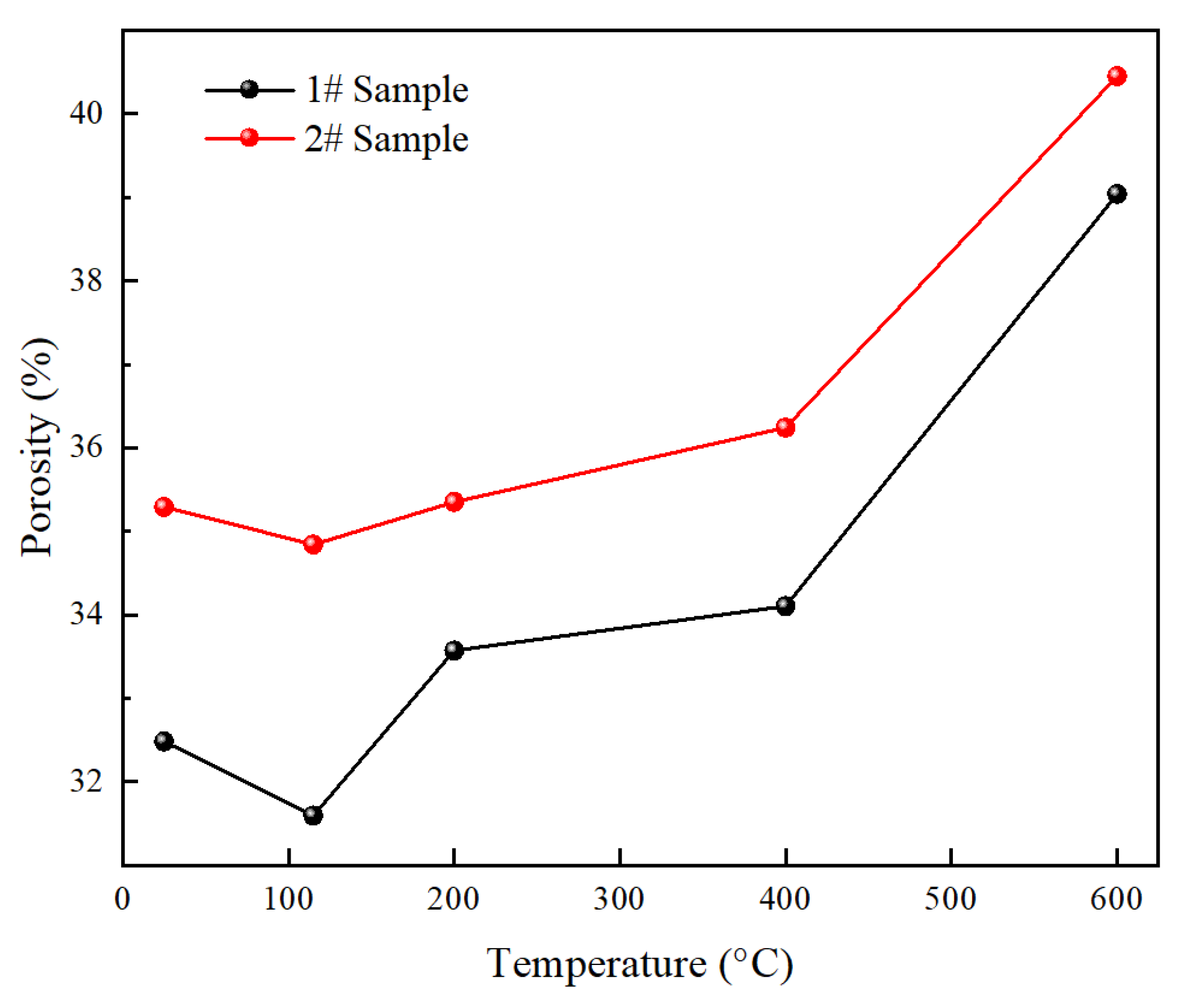



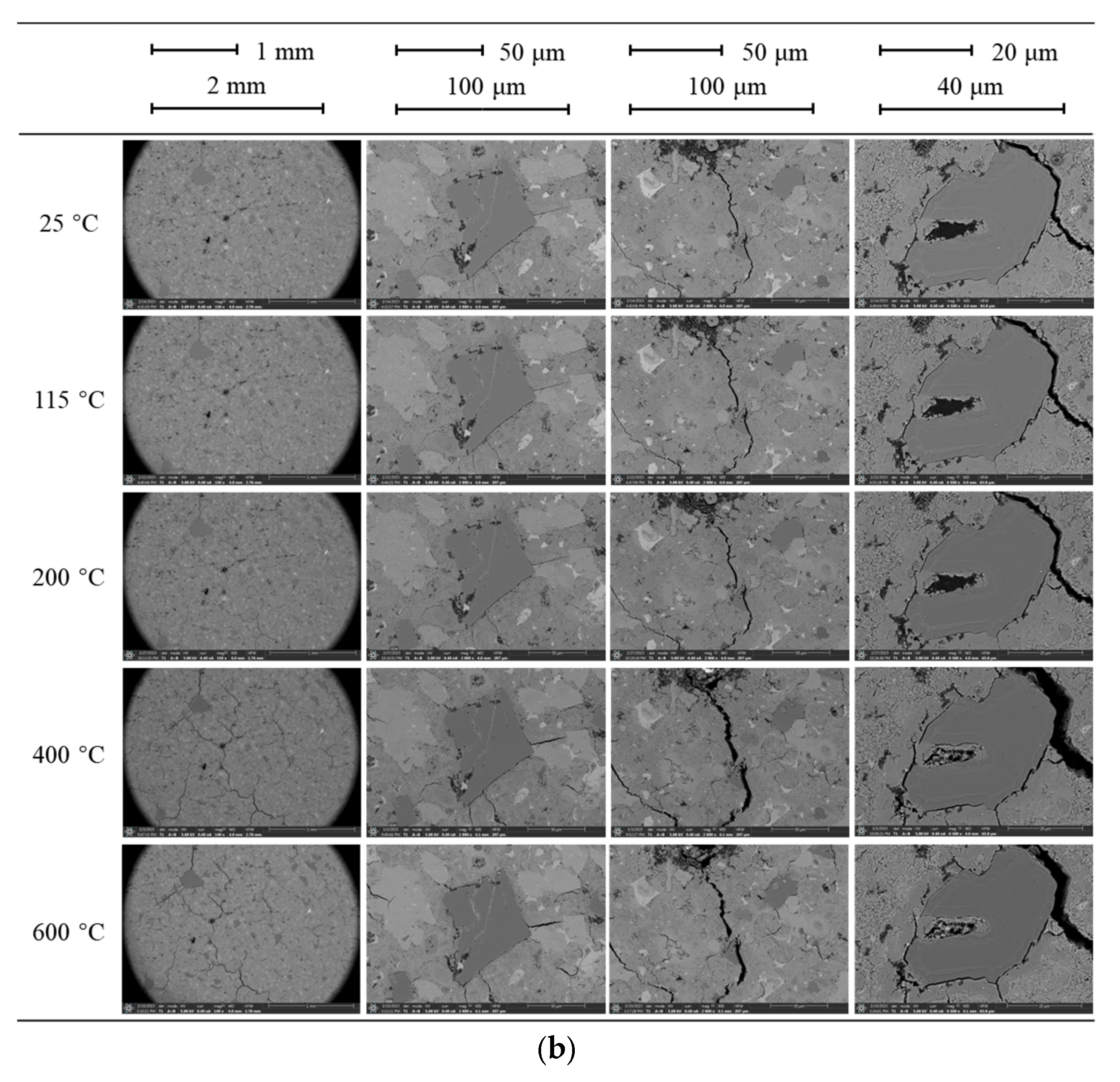
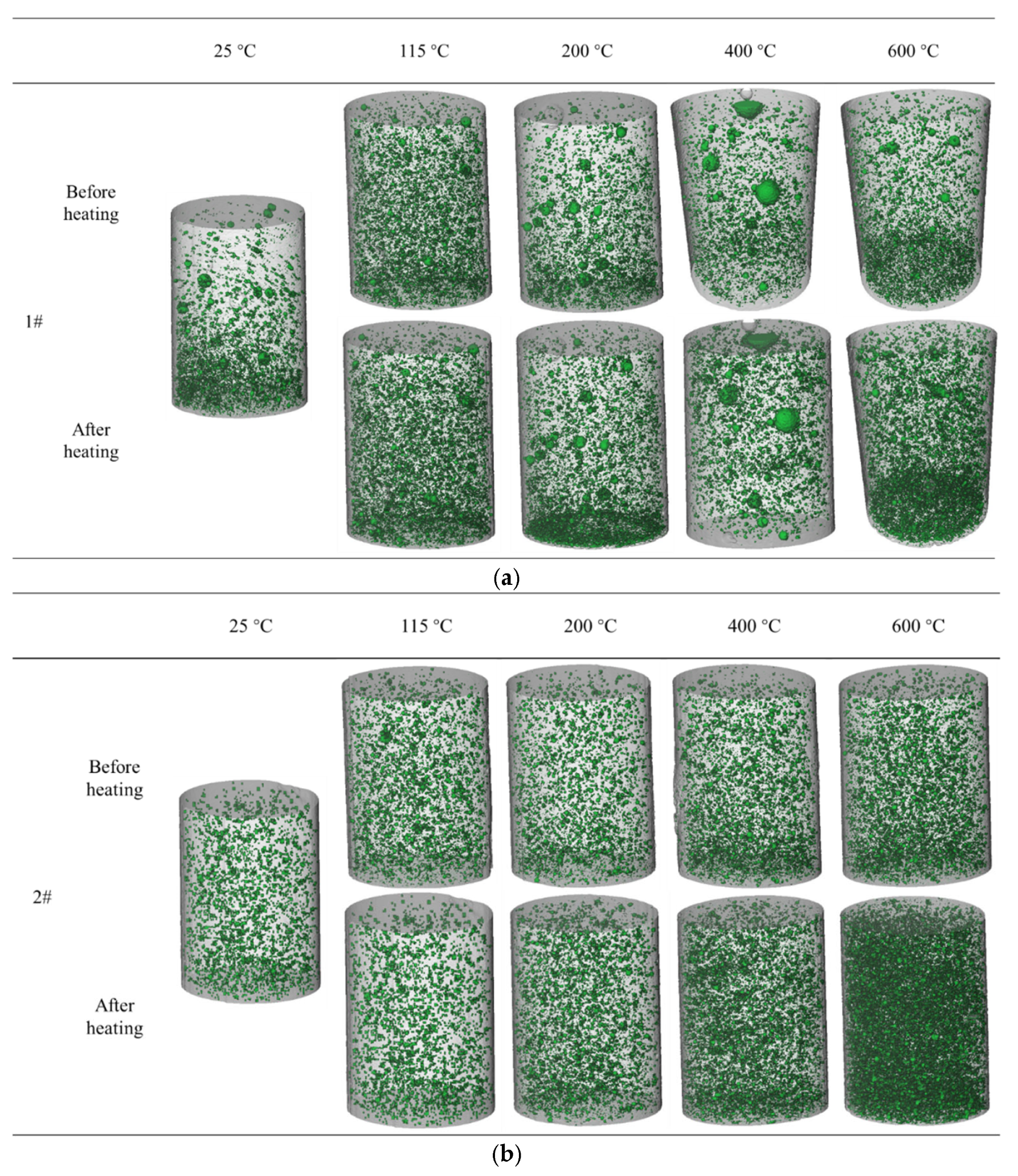
Disclaimer/Publisher’s Note: The statements, opinions and data contained in all publications are solely those of the individual author(s) and contributor(s) and not of MDPI and/or the editor(s). MDPI and/or the editor(s) disclaim responsibility for any injury to people or property resulting from any ideas, methods, instructions or products referred to in the content. |
© 2024 by the authors. Licensee MDPI, Basel, Switzerland. This article is an open access article distributed under the terms and conditions of the Creative Commons Attribution (CC BY) license (https://creativecommons.org/licenses/by/4.0/).
Share and Cite
Xi, Y.; Xing, J.; Feng, J.; Ma, C.; Yang, X.; Tian, Y.; Liu, X. Experimental Study on the Evolution Law of the Mechanical and Pore Characteristic Parameters of Set Cement under High- and Ultra-High-Temperature Treatments. Buildings 2024, 14, 303. https://doi.org/10.3390/buildings14010303
Xi Y, Xing J, Feng J, Ma C, Yang X, Tian Y, Liu X. Experimental Study on the Evolution Law of the Mechanical and Pore Characteristic Parameters of Set Cement under High- and Ultra-High-Temperature Treatments. Buildings. 2024; 14(1):303. https://doi.org/10.3390/buildings14010303
Chicago/Turabian StyleXi, Yan, Junhao Xing, Jiajia Feng, Congming Ma, Xiutian Yang, Yudong Tian, and Xin Liu. 2024. "Experimental Study on the Evolution Law of the Mechanical and Pore Characteristic Parameters of Set Cement under High- and Ultra-High-Temperature Treatments" Buildings 14, no. 1: 303. https://doi.org/10.3390/buildings14010303






